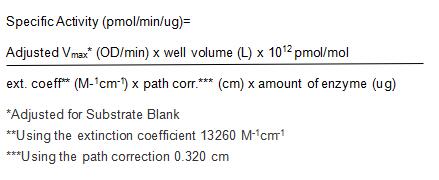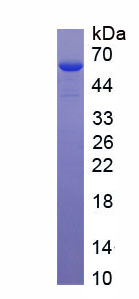Active Phospholipase A2 Group VII (LpPLA2) 

PLA2G7; PAF-AH; PAFAH; Lp-PLA2; LDL-PLA2; Platelet Activating Factor Acetylhydrolase,Plasma; Phospholipase A2,Group VII; LDL-associated phospholipase A2; Phospholipase A2, Lipoprotein Associated
- UOM
- FOB US$ 320.00 US$ 800.00 US$ 1,600.00 US$ 4,800.00 US$ 12,000.00
- Quantity
Overview
Properties
- Product No.APA867Ra61
- Organism SpeciesRattus norvegicus (Rat) Same name, Different species.
- ApplicationsCell culture; Activity Assays.
Research use only - DownloadInstruction Manual
- CategoryEnzyme & KinaseMetabolic pathwayInfection immunity
- Buffer FormulationPBS, pH7.4, containing 5% Trehalose.
- Traits Freeze-dried powder, Purity > 95%
- Isoelectric Point7.6
Sign into your account
Share a new citation as an author
Upload your experimental result
Review

Contact us
Please fill in the blank.
Activity test

PLA2G-VII which is also known as Lp-PLA2, is a plasma enzyme bound to lipoproteins: 80% bound to LDL, 15%-20% to HDL, and the remainder to VLDL. It is produced in major by mature macrophages and activated platelets. In contrast to other classical sPLA2s, PLA2G-VII has poor specificity toward Sn-2 long chain fatty acids, unless heavily oxidized, and undergoes the catalysis of its substrates in the aqueous phase rather than at the interfacial surface of lipids. Thus, it has high specificity for water-soluble phospholipids in plasma including oxidatively-modified phospholipids and platelet-activating factor (PAF). Because of the latter activity, it is also known as PAF acetylhydrolase (PAF-AH). Lack of human PLA2G-VII is related to a higher risk for stroke and heart disease.The activity of recombinant rat PLA2G-VII was measured by its ability to cleave a colorimetric peptide substrate 1-O-hexadecyl-2-deoxy-2-thio-S-acetyl-sn-glyceryl-3-phosphorylcholine (2-Thio-PAF). The reaction was performed in 50 mM MES, 150 mM NaCl, 0.1 mg/mL BSA, pH 6.5 (Assay Buffer), initiated by addition 50 μL of various concentrations of PLA2G-VII (diluted by Assay Buffer) to 50 µL of 0.2 mM Substrate and 0.2 mM DTNB mixture. The final well serves as a negative control with no PLA2G-VII, replaced with 50 μL assay buffer. Then read absorbance at 405 nm in kinetic mode for 5 minutes. The specific activity of recombinant rat PLA2G-VII is 112.37 pmol/min/µg.
Usage
Reconstitute in 10mM PBS (pH7.4) to a concentration of 0.1-1.0 mg/mL. Do not vortex.
Storage
Avoid repeated freeze/thaw cycles. Store at 2-8°C for one month. Aliquot and store at -80°C for 12 months.
Stability
The thermal stability is described by the loss rate. The loss rate was determined by accelerated thermal degradation test, that is, incubate the protein at 37°C for 48h, and no obvious degradation and precipitation were observed. The loss rate is less than 5% within the expiration date under appropriate storage condition.
Increment services
-
 BCA Protein Quantification Kit
BCA Protein Quantification Kit
-
 Molecular Mass Marker for Protein
Molecular Mass Marker for Protein
-
 Monoclonal Antibody Customized Service
Monoclonal Antibody Customized Service
-
 Polyclonal Antibody Customized Service
Polyclonal Antibody Customized Service
-
 Protein Activity Test Experiment Service
Protein Activity Test Experiment Service
-
 Electrophoretic Mobility Shift Assay (EMSA) Experiment Service
Electrophoretic Mobility Shift Assay (EMSA) Experiment Service
-
 Buffer
Buffer
-
 Lentivirus Packaging Experiment Service
Lentivirus Packaging Experiment Service
-
 Adenovirus Packaging Experiment Service
Adenovirus Packaging Experiment Service
-
 Real Time PCR Experimental Service
Real Time PCR Experimental Service
-
 Spike RBD Protein (S-RBD)
Spike RBD Protein (S-RBD)
-
 Protein G
Protein G
-
 Protein A
Protein A
Citations
- The effects of different intensity walking programs on serum blood lipids, high-sensitive C-reactive protein, and lipoprotein-associated phospholipase A2 in premenopausal womenScienceDirect: S0765159710000262
- Association of Serum Lipoprotein-Associated Phospholipase A2 Level with Nonalcoholic Fatty Liver DiseaseWiley: source
- Effects of Pycnogenol on endothelial function in patients with stable coronary artery disease: a double-blind, randomized, placebo-controlled, cross-over studyPubMed: 22240497
- Effects of Lipid-Lowering Drugs on Irisin in Human Subjects In Vivo and in Human Skeletal Muscle Cells Ex VivoPubMed: PMC3759413
- Influence of Tongfengtai Granules on Inflammatory Factor in Acute Gouty Arthritis Model RatsSource
- Everolimus therapy is associated with reduced lipoprotein-associated phospholipase A2 (Lp-Pla2) activity and oxidative stress in heart transplant recipients.Pubmed: 23958269
- Lipoprotein-Associated Phospholipase A2 Mass Level Is Increased in Elderly Subjects with Type 2 Diabetes MellitusHindawi: 278063
- The Role of Asymmetric Dimethylarginine and Lipoprotein Associated Phospholipase A2 in Children and Adolescents with DyslipidemiaScirp:Source
- In vitro lipid-lowering and fibrinolytic effects of regulatory leucine-containing glyprolines in human bloodSpringer:Source
- Lipoprotein-associated phospholipase A2 and AGEs are associated with cardiovascular risk factors in women with history of gestational diabetes mellitus.Pubmed:24397392
- Lipoprotein-Associated Phospholipase A 2 Mass Level Is Increased in Elderly Subjects with Type 2 Diabetes MellitusPubmed:24818163
- Effects of sitagliptin therapy on markers of low-grade inflammation and cell adhesion molecules in patients with type 2 diabetesPubmed:25034387
- Effect of Extended‐Release Niacin on High‐Density Lipoprotein (HDL) Functionality, Lipoprotein Metabolism, and Mediators of Vascular Inflammation in Statin‐Treated PatientsPubMed: 26374297
- VEbscohost
- Effect of Pitavastatin Treatment on ApoB-48 and Lp-PLA2 in Patients with Metabolic Syndrome: Substudy of PROspective Comparative Clinical Study Evaluating the Efficacy and Safety of PITavastatin in Patients with Metabolic Syndromepmc:PMC4803547
- Effect of dipyridamole on myocardial reperfusion injury: A double‐blind randomized controlled trial in patients undergoing elective coronary artery bypass surgeryPubmed:25773594
- Effect of intensive insulin treatment on plasma levels of lipoprotein-associated phospholipase A 2 and secretory phospholipase A 2 in patients with newly …articles:10.1186
- SERUM LIPOPROTEIN-ASSOCIATED PHOSPHOLIPASE A2 IN MALES WITH METABOLIC SYNDROME AND OBSTRUCTIVE SLEEP APNEA.jrnl:1841098
- Biomarker for diagnosis of moyamoya disease:
- Circulating fatty-acid binding-protein 4 levels predict CV events in patients after coronary interventionsPubmed: 32859455
- Can admission lipoprotein-associated phospholipase A2 predict the symptomatic cerebral vasospasm following aneurysmal subarachnoid hemorrhage?







